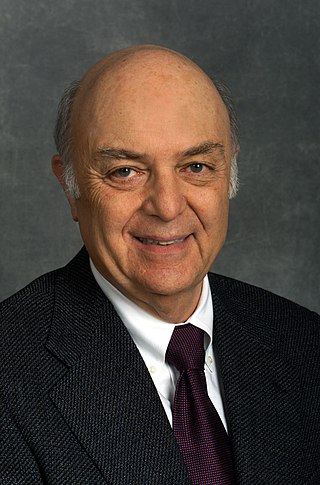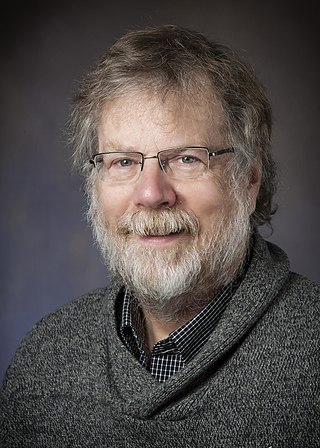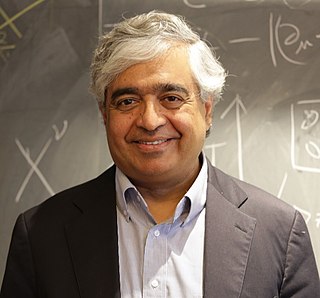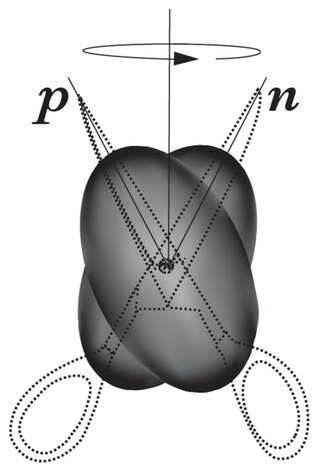
Mott insulators are a class of materials that are expected to conduct electricity according to conventional band theories, but turn out to be insulators. These insulators fail to be correctly described by band theories of solids due to their strong electron–electron interactions, which are not considered in conventional band theory. A Mott transition is a transition from a metal to an insulator, driven by the strong interactions between electrons. One of the simplest models that can capture Mott transition is the Hubbard model.
Surface layering is a quasi-crystalline structure at the surfaces of otherwise disordered liquids, where atoms or molecules of even the simplest liquid are stratified into well-defined layers parallel to the surface. While in crystalline solids such atomic layers can extend periodically throughout the entire dimension of a crystal, surface layering decays rapidly away from the surface and is limited to just a few near-surface region layers. Another difference between surface layering and crystalline structure is that atoms or molecules of surface-layered liquids are not ordered in-plane, while in crystalline solids they are.
Oleg Sushkov is a professor at the University of New South Wales and a leader in the field of high temperature super-conductors. Educated in Russia in quantum mechanics and nuclear physics, he now teaches in Australia.
Jozef T. Devreese is a Belgian scientist, with a long career in condensed matter physics. He is Professor Emeritus of Theoretical Physics at the University of Antwerp.

Marvin Lou Cohen is an American–Canadian theoretical physicist. He is a physics professor at the University of California, Berkeley. Cohen is a leading expert in the field of condensed matter physics. He is widely known for his seminal work on the electronic structure of solids.
Quantum dimer models were introduced to model the physics of resonating valence bond (RVB) states in lattice spin systems. The only degrees of freedom retained from the motivating spin systems are the valence bonds, represented as dimers which live on the lattice bonds. In typical dimer models, the dimers do not overlap.
The reactive empirical bond-order (REBO) model is a function for calculating the potential energy of covalent bonds and the interatomic force. In this model, the total potential energy of system is a sum of nearest-neighbour pair interactions which depend not only on the distance between atoms but also on their local atomic environment. A parametrized bond order function was used to describe chemical pair bonded interactions.

Xiao-Gang Wen is a Chinese-American physicist. He is a Cecil and Ida Green Professor of Physics at the Massachusetts Institute of Technology and Distinguished Visiting Research Chair at the Perimeter Institute for Theoretical Physics. His expertise is in condensed matter theory in strongly correlated electronic systems. In Oct. 2016, he was awarded the Oliver E. Buckley Condensed Matter Prize.

David Matthew Ceperley is a theoretical physicist in the physics department at the University of Illinois Urbana-Champaign or UIUC. He is a world expert in the area of Quantum Monte Carlo computations, a method of calculation that is generally recognised to provide accurate quantitative results for many-body problems described by quantum mechanics.

Subir Sachdev is Herchel Smith Professor of Physics at Harvard University specializing in condensed matter. He was elected to the U.S. National Academy of Sciences in 2014, and received the Lars Onsager Prize from the American Physical Society and the Dirac Medal from the ICTP in 2018. He was a co-editor of the Annual Review of Condensed Matter Physics from 2017–2019.
Swift heavy ions are the components of a type of particle beam with high enough energy that electronic stopping dominates over nuclear stopping. They are accelerated in particle accelerators to very high energies, typically in the MeV or GeV range and have sufficient energy and mass to penetrate solids on a straight line. In many solids swift heavy ions release sufficient energy to induce permanently modified cylindrical zones, so-called ion tracks. If the irradiation is carried out in an initially crystalline material, ion tracks consist of an amorphous cylinder. Ion tracks can be produced in many amorphizing materials, but not in pure metals, where the high electronic heat conductivity dissipates away the electronic heating before the ion track has time to form.
Daniel L. Stein is an American physicist and Professor of Physics and Mathematics at New York University. From 2006 to 2012 he served as the NYU Dean of Science.

David R. Nelson is an American physicist, and Arthur K. Solomon Professor of Biophysics, at Harvard University.
Juan Carlos Campuzano is a Paraguayan American physicist. He is a Distinguished Professor of Physics at the University of Illinois at Chicago. He was a Distinguished Fellow at Argonne National Laboratory, and a he is also a 2001 American Physical Society Fellow and a recipient of the 2011 Oliver Buckley Prize in Condensed Matter Physics. He is an expert in high-temperature superconductivity.
In quantum many-body physics, topological degeneracy is a phenomenon in which the ground state of a gapped many-body Hamiltonian becomes degenerate in the limit of large system size such that the degeneracy cannot be lifted by any local perturbations.

Scissors Modes are collective excitations in which two particle systems move with respect to each other conserving their shape. For the first time they were predicted to occur in deformed atomic nuclei by N. LoIudice and F. Palumbo, who used a semiclassical Two Rotor Model, whose solution required a realization of the O(4) algebra that was not known in mathematics. In this model protons and neutrons were assumed to form two interacting rotors to be identified with the blades of scissors. Their relative motion (Fig.1) generates a magnetic dipole moment whose coupling with the electromagnetic field provides the signature of the mode.
The semicircle law, in condensed matter physics, is a mathematical relationship that occurs between quantities measured in the quantum Hall effect. It describes a relationship between the anisotropic and isotropic components of the macroscopic conductivity tensor σ, and, when plotted, appears as a semicircle.
Boris Ionovich Shklovskii is a theoretical physicist, at the William I Fine Theoretical Physics Institute, University of Minnesota, specializing in condensed matter. Shklovskii earned his A.B. degree in Physics, in 1966 and a Ph.D. in condensed matter theory, in 1968 from Leningrad University.
Giovanni Vignale is an Italian American physicist and Professor of Physics at the University of Missouri. Vignale is known for his work on density functional theory - a theoretical approach to the quantum many-body problem - and for several contributions to many-particle physics and spintronics. He is also the author of a monograph on the "Quantum Theory of the Electron Liquid" and a book entitled "The Beautiful Invisible - Creativity, imagination, and theoretical physics".
Bogdan Andrei Bernevig is a Romanian Quantum Condensed Matter Professor of Physics at Princeton University and the recipient of the John Simon Guggenheim Fellowship in 2017.






